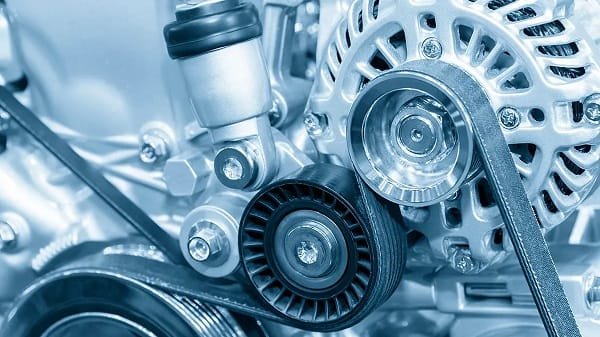Introduction
For many, the car is an indispensable part of daily life, whether for commuting, running errands, or long road trips. Despite this reliance, few people understand the complex systems that keep their vehicles running smoothly. Among these components, the alternator plays an essential role that often goes unnoticed—until it fails. The alternator is responsible for keeping the battery charged and powering the car’s electrical systems while the engine runs. This comprehensive article will explore how alternators work and explain why they are critical for your vehicle’s functionality and reliability.
Working Mechanism of an Alternator
At its core, an alternator is a generator designed to convert mechanical energy into electrical energy. This conversion is crucial because it powers the vehicle’s electrical systems and ensures the battery remains charged. The process begins with the engine, which powers a belt connected to the alternator’s pulley. As the engine runs, it turns this pulley and rotates the alternator’s rotor—a central component wrapped with copper wire—to create a magnetic field. Within the alternator, a stationary set of wire coils, known as the stator, surrounds the rotor. As the rotor spins, it produces alternating current (AC) in the stator. A rectifier converts this AC into direct current (DC), making it suitable for the vehicle’s electrical components. Understanding this process is vital for realizing the importance of maintaining parts like alternators Winter Garden FL, or any location.
Components of an Alternator
The alternator is a complex assembly of various components, each vital for effective operation. The rotor and stator are at the heart of the alternator’s function. The rotor, driven by engine power, spins rapidly to generate a magnetic field. The stator, which encases the rotor, comprises multiple coils of wire that capture this magnetic energy to produce electricity. Another crucial part is the voltage regulator. This component ensures the electrical output remains within safe limits, protecting the car’s battery and electrical systems from voltage spikes or drops. The rectifier plays another indispensable role, converting the AC output from the stator into the DC needed to operate the vehicle’s electrical systems and recharge the battery. Additionally, a cooling fan and various housing components help maintain the alternator’s performance by dissipating heat and protecting internal parts.
The Significance of Alternators in Vehicles
The alternator’s significance lies in its dual function: providing power to the vehicle’s electrical systems while simultaneously charging the battery. When you start your car, the battery provides the energy needed to ignite the engine. Once the engine runs, the alternator takes over, powering essential components such as headlights, the radio, and the air conditioning system. This transition is crucial not only for vehicle operation but also for battery preservation. The battery would rapidly drain without a functioning alternator, causing the car to stall and leaving you stranded. Thus, the alternator is the vehicle’s lifeline, ensuring a continuous power supply and reliable performance. Its efficient operation can even impact fuel economy, as a well-functioning alternator places less strain on the engine.
Symptoms of a Failing Alternator
Detecting the early warning signs of a failing alternator can save you from inconvenient breakdowns and costly repairs. One common symptom is dimming or flickering headlights, which indicate that the car’s electrical components aren’t receiving consistent power. You might also notice strange noises, such as whining or grinding, coming from under the hood, suggesting issues with the alternator’s bearings. Another telltale sign is the slow functioning of electrical components, such as power windows or seat warmers, indicating an inadequate power supply. Perhaps the most definitive symptom is the warning light on your dashboard, often shaped like a battery or with an “ALT” or “GEN” label, illuminating to signal a malfunctioning charging system. Addressing these signs promptly with professional assistance can prevent further damage and ensure a reliable drive.
Maintenance Tips for Long-Lasting Alternators
Proper maintenance is key to extending an alternator’s lifespan and enhancing vehicle performance. Regular inspections can help you catch potential issues before they escalate. Start by checking the drive belt for signs of wear or improper tension, which can affect the alternator’s ability to generate power. It’s also essential to keep the alternator and surrounding areas clear of dirt and debris, preventing overheating and mechanical stress. Ensuring all electrical connections are secure and corrosion-free will enhance electrical flow and reduce the risk of malfunction. Checking your battery’s health is equally crucial, as a weak or failing battery can strain the alternator. Avoid overloading the electrical system with unnecessary accessories or equipment, as this can overtax the alternator. Incorporating these simple maintenance practices ensures your alternator runs efficiently, supporting your vehicle’s overall health and reliability.
Conclusion
In summary, the alternator is a vital component of your vehicle, crucial for its proper functionality and efficiency. By understanding how it works and its importance, you can better appreciate its role in your car’s operation. Regular maintenance and immediate attention to any signs of trouble can prevent significant issues, ensuring that your vehicle remains a reliable means of transportation. By keeping your alternator and its related systems in good condition, you enhance your driving experience and contribute to the longevity of your vehicle, ensuring it remains a steadfast companion in your daily life.



